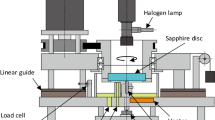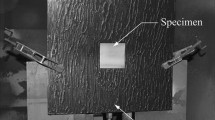Abstract
A furnace endoscope was developed to carry out in-furnace measurements of black liquor sprays in order to discover the initial velocity, opening angle and trajectory of the spray, and compare spray disintegration mechanisms and spray appearance with the ones measured in a spray chamber. An error analysis of the velocity measurement method was carried out, and the meaning of the optimum measurement distance from the optics to the observed object is discussed. Some details of the development process of the probe are also presented, especially the definition of the scale of the image and the cooling system of the protection tubes. The furnace endoscope can be used in difficult conditions, such as those found inside a chemical recovery boiler (~1,200°C and corrosive chemicals) with promising and accurate measurement results. The equipment has been tested in several furnaces.











Similar content being viewed by others
Abbreviations
- d :
-
Distance from endoscope lens to spray surface (m)
- d px :
-
Measured distance in a frame (pixels)
- d fr :
-
Vertical size of the frame (pixels)
- s :
-
Distance that the spray has moved during t (m)
- t :
-
Time (exposure time+delay) (s)
- u :
-
Velocity of a spray (m/s)
- α :
-
Angle of view (°)
- Δd:
-
Error in measuring d (m)
- Δdpx:
-
Error in measuring dpx (pixels)
- Δt:
-
Error in time (s)
- ΔTe:
-
Excess temperature (°C)
- ε :
-
Absolute error (maximum) (m/s)
- ε*:
-
Relative error (%)
References
Asplund D (1997) The status and development possibilities of bioenergy in energy industry (in Finnish). Energy Department, Ministry of Trade and Industry, Finland
Doebelin EO (1990) Measurement systems application and design, 4th edn. McGraw-Hill, New York, pp 58–59
Fraser RP (1956) Liquid fuel atomization. In: Proceedings of the 6th symposium on combustion, New Haven, Connecticut, 19–24 August 1956, pp 687–701
Helpiö T, Kankkunen A (1996) The effect of black liquor firing temperature on atomization performance. Tappi J 79(9):158–163
Kankkunen A, Nieminen K (1997) Black liquor sheet breakup mechanisms and the effect on the droplet size. In: Proceedings of the 7th international conference on liquid atomization and spray systems (ICLASS’97), Seoul, Korea, 18–22 August 1997
Lu G, Yan Y, Ward DD (2000) Advanced monitoring, characterisation and evaluation of gas-fired flames in a utility boiler. J Inst Energy 73:43–49
McCarty BC, Lang B (2002) Furnace cameras assist in NOx reduction, Power Eng 106:138–144
Media Cybernetics (1998) Image-Pro Plus: reference guide for Windows, pp 209–219
Merzkirch W (1987) Flow visualization. Academic Press, Orlando, Florida, p 51
Miikkulainen P, Järvinen M, Kankkunen A (2000) Black liquor spray properties in operating recovery boiler furnaces. In: Proceedings of the 5th European conference on industrial furnaces and boilers (INFUB 2000), Porto, Portugal, 11–14 April 2000
Miikkulainen P, Kankkunen A, Järvinen M (2002a) The effect of excess temperature and flashing on black liquor spray properties. In: Proceedings of the Finnish–Swedish flame days 2002, Vaasa, Finland, 24–25 September 2002
Miikkulainen P, Järvinen M, Kankkunen A (2002b) The effect of a furnace environment on black liquor spray properties. Pulp Pap–Canada 103(9):T238–242 (pp 34–38)
Råde L, Westergren B (1998) BETA, mathematics handbook for science and engineering. Studentlitteratur, Lund Institute of Technology, Lund, Sweden, p 347
Spielbauer TM, Aidun CK (1992) Mechanism of liquid sheet breakup and the resulting droplet size distributions, part 2: strand breakup and experimental observations. Tappi J 73(3):195–200
Westerweel J (1997) Fundamentals of digital particle image velocimetry. Meas Sci Technol 8:1379–1392
Acknowledgements
The development work and experiments reported in this work were carried out in the research projects funded by the National Technology Agency of Finland, the Academy of Finland (project number 53606), Aker Kvaerner and the Andritz Corporation. We also thank the mill personnel for their valuable help.
Author information
Authors and Affiliations
Corresponding author
Rights and permissions
About this article
Cite this article
Miikkulainen, P., Kankkunen, A. & Järvinen, M.P. Furnace endoscope—measuring fuel spray properties in hot and corrosive environments. Exp Fluids 37, 910–916 (2004). https://doi.org/10.1007/s00348-004-0884-1
Received:
Accepted:
Published:
Issue Date:
DOI: https://doi.org/10.1007/s00348-004-0884-1




